In this dynamic world of apparel retail, inventory management is a critical function. Effective inventory management ensures right products are available at the right time.
Managing inventory in an apparel retail store is complex. It involves multitude of variables and requires meticulous attention to detail. Traditional methods of inventory management, such as manual tracking or spreadsheets, are no longer sufficient. They are always prone to errors and inefficiencies.
This post has the list of the top apparel inventory management tools. We explore their importance, features, and how to use those tools to optimize entire inventory management process.
Importance of Inventory Management Tools in Apparel Retail
Apparel retail management tools are crucial for several reasons. They help apparel retailers maintain optimal stock levels, meet customer demand without overstocking or understocking, drive sales, enhance customer experience, improve profitability, and respond to market trends effectively.
These tools provide real-time inventory data, enable informed decision-making about product assortment, pricing, and promotions, and offer features like categorization, integration with POS systems, analytics capabilities, inventory forecasting, demand planning, purchase order management, and raw materials management.
Additionally, retail SMS marketing drives sales, enhances engagement, and streamlines customer communication.
Why Is Apparel Inventory Management important?
Apparel inventory management is crucial for retailers for several reasons. First, it affects customer satisfaction. When customers find the products they want in the right sizes and colors, they are likely to make a purchase. This not only drives sales but also enhances customer experience, leading to repeat business.
Secondly, apparel inventory management affects a retailer's profitability. By maintaining optimal stock levels, retailers can avoid the costs associated with overstocking or understocking.
Finally, apparel inventory management plays a key role in a retailer's ability to respond to market trends. With real-time inventory data, retailers make informed decisions about product assortment, pricing, and promotions.
Manual vs. Software Tools for Apparel Inventory Management
Apparel retail inventory management has traditionally been a manual process. However, with right software tools, a lot of other software tools have emerged as the winner.
1. Manual Inventory Management Tool
Manual inventory management involves physically counting items & recording stock levels on paper. While this method is feasible for small retailers, it is time-consuming and prone to human error.
However, manual inventory management does not provide real-time data. This leads to delay in decision-making and missed opportunities to respond to market trends.
Spreadsheet Inventory Management
Many retailers upgrade from manual to spreadsheet inventory management. Spreadsheets allow for more organized record-keeping and easier data analysis.
Spreadsheet inventory management also has its limitations. Like manual methods, it is susceptible to human error. Additionally, maintaining up-to-date spreadsheets can be labor-intensive, especially for retailers with large inventories.
2. Software Inventory Management
Software inventory management is a more advanced tool. Such a tool automates many of the tasks associated with manual and spreadsheet methods, reducing risk of human error.
For apparel retailers evaluating their tech stack, exploring the best fashion inventory software can provide clarity on which platform best suits their operational complexity and growth stage.
Inventory management tools provides real-time data, enabling retailers to make timely decisions. It also offers features such as categorization, that aids in stock organization, and integration capabilities with POS systems for seamless inventory tracking.
Moreover tools come with analytics capabilities. These provide valuable insights into sales trends, helping retailers optimize their inventory management strategies.
Still got questions? Get answers to the 5 most pressing inventory questions from the Limited Supply Podcast in this article.
Key Features of Apparel Inventory Management Tools for 2025
The right apparel inventory management tool offers a range of features designed to streamline and optimize inventory processes. These features significantly enhance efficiency and accuracy of inventory management in apparel retail:
Inventory Forecasting
Inventory forecasting is an essential aspect of retail management, particularly in the dynamic apparel industry. It involves predicting future inventory needs based on a combination of historical sales data, seasonal trends, and market demands. Accurate forecasting is crucial for ensuring that the right products are available at the right time, minimizing the risks associated with stockouts or excess inventory.
AI in inventory management go beyond traditional forecasting, enabling apparel retailers to process vast datasets, detect complex demand patterns, and adapt quickly to market changes.
Prediko's Advantage
Prediko elevates the inventory forecasting process through its advanced predictive analytics capabilities. Our AI has been trained on 15 million SKUs across 25+ industries to identify patterns and trends that may not be immediately apparent.
This approach enables apparel retailers to generate highly accurate and tailored forecasts that align with their specific product lines and customer behaviors. With Prediko, businesses can optimize inventory levels, better respond to market changes, and ultimately drive higher profitability and operational efficiency.
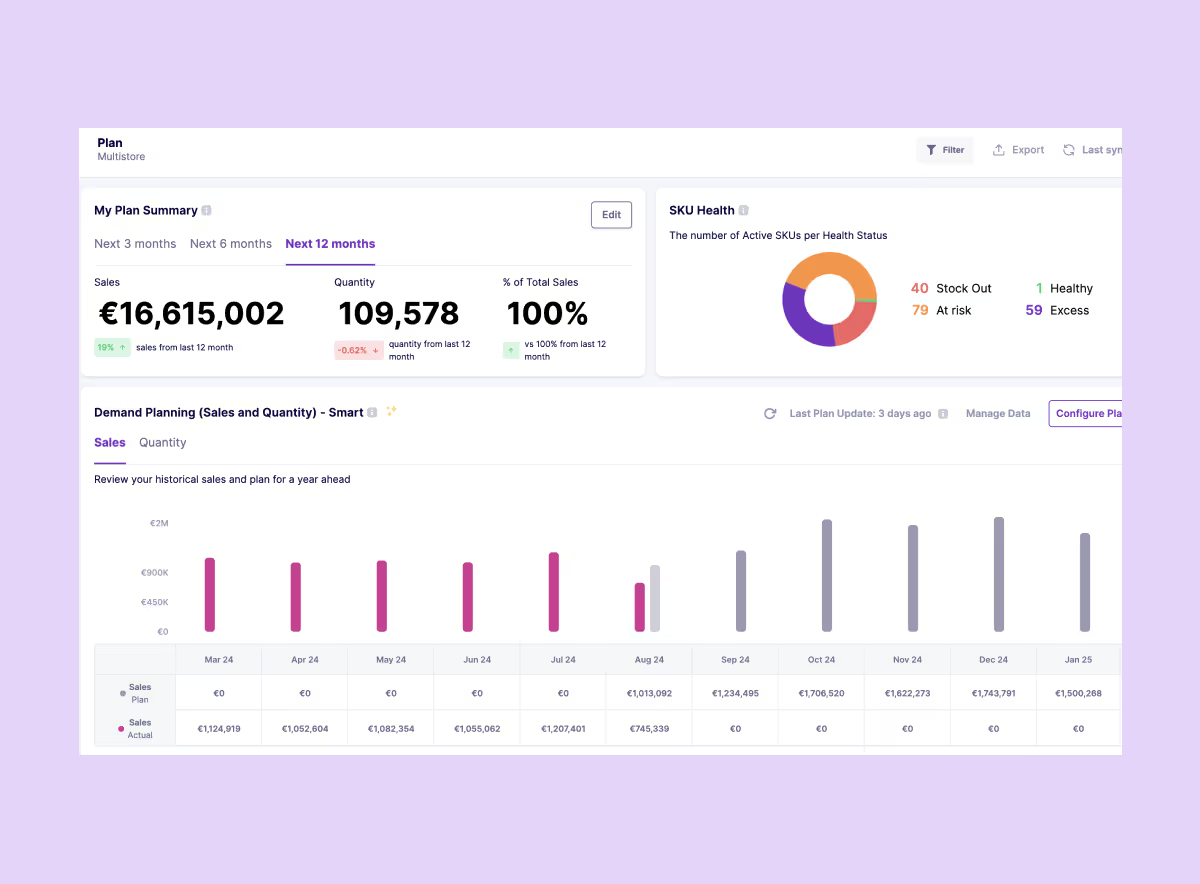
Demand Planning
Demand planning is a strategic process that involves predicting future customer demand to ensure that the right products are available in the right quantities at the right time.
In the apparel industry, where trends shift rapidly and customer preferences are unpredictable, effective demand planning is crucial for maintaining inventory balance and minimizing waste. Accurate demand planning helps retailers align their inventory with market needs, reduce excess stock, and avoid missed sales opportunities due to stockouts.
Prediko's Advantage
Prediko enhances demand planning process by leveraging its advanced data analytics and machine learning capabilities. The platform integrates various data sources, including historical sales, market trends, and external factors, to produce precise demand forecasts. Prediko's AI goes beyond traditional methods by continuously learning and adapting to new data, ensuring that demand plans are always aligned with current market conditions.
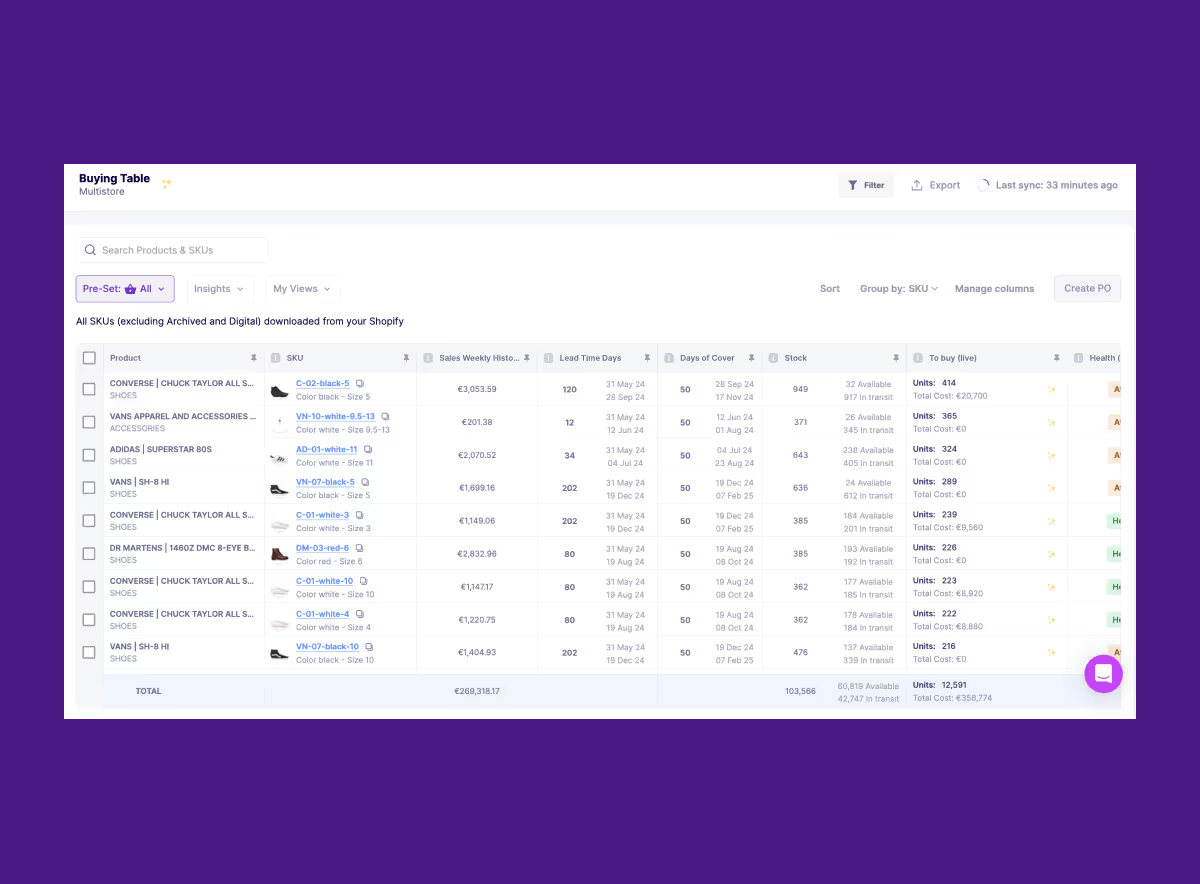
Purchase Order Management
Purchase Order management is an important function in retail operations that involves creation, tracking, and management of purchase orders from suppliers. In the apparel industry, where inventory needs fluctuate rapidly due to changing trends and seasonal demands, efficient purchase order management is essential.
Prediko's Advantage
Prediko's approach to purchase order management is by integrating advanced analytics and automation into the process. The app provides real-time insights into inventory levels and sales trends, enabling retailers to make informed decisions about when and what to order. Prediko’s system automates many aspects of purchase order creation, reducing risk of errors and saving valuable time.
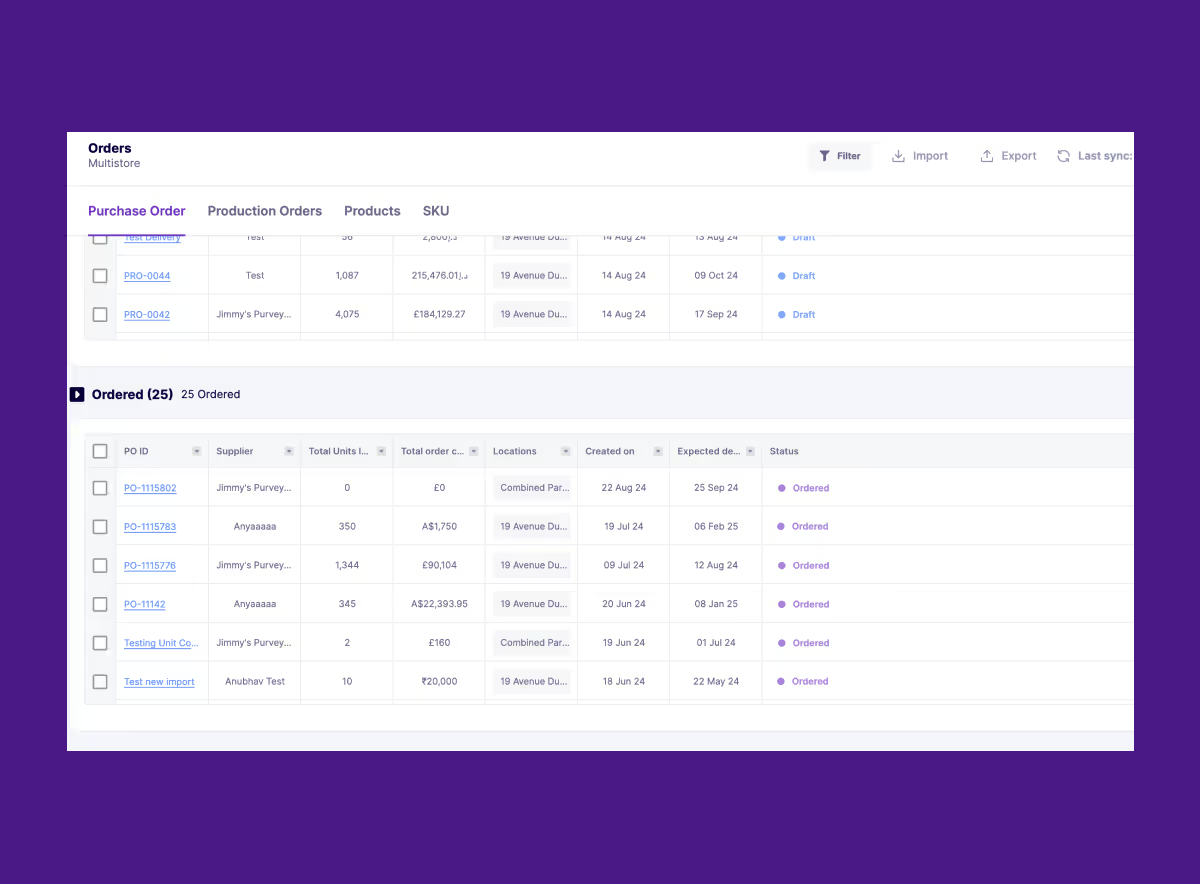
Raw Materials Management
Raw materials management is fundamental aspect of the supply chain in the apparel industry. It involves efficient procurement, storage, and utilization of raw materials, such as fabrics, threads, and other essential components required for manufacturing apparel. Effective raw materials management ensures that production processes are not disrupted due to material shortages or delays.
Prediko's Advantage
Prediko offers a comprehensive solution for managing raw materials in the apparel industry. With the ability to create and maintain a detailed raw materials catalogue, Prediko provides retailers and manufacturers with tools needed to manage their inventory effectively.
This app emphasizes real-time tracking of material levels and usage rates, ensuring that businesses have up-to-date insights into their stock. We have also covered the list of the best raw materials management apps.
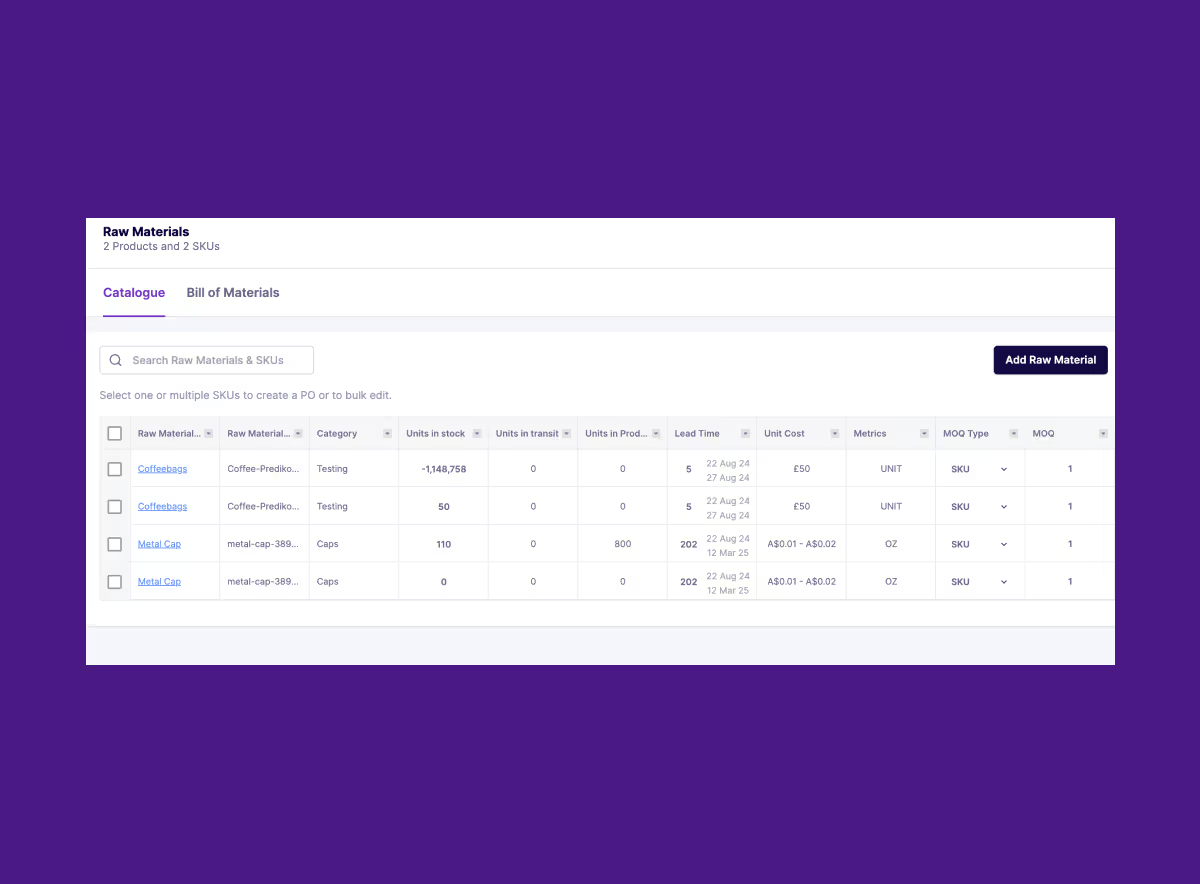
Comparison Table of the Best Apparel Inventory Management Tools
Best Apparel Inventory Management Tools
The current Shopify ecosystem offers multiple apparel inventory management tools, each with its unique features and capabilities. These tools significantly enhance the efficiency and accuracy of inventory management in apparel retail space.
5.0 ⭐ (100+ Reviews on Shopify Store)
Prediko combines AI-powered inventory forecasting, planning, and purchase order management into one easy-to-use app. Say goodbye to spreadsheets and save up to 3 hours each day with real-time syncing to Shopify.
Stay ahead with automated inventory alerts and stock health indicators, so you can quickly create data-driven purchase orders and avoid running out of stock or overstocking.
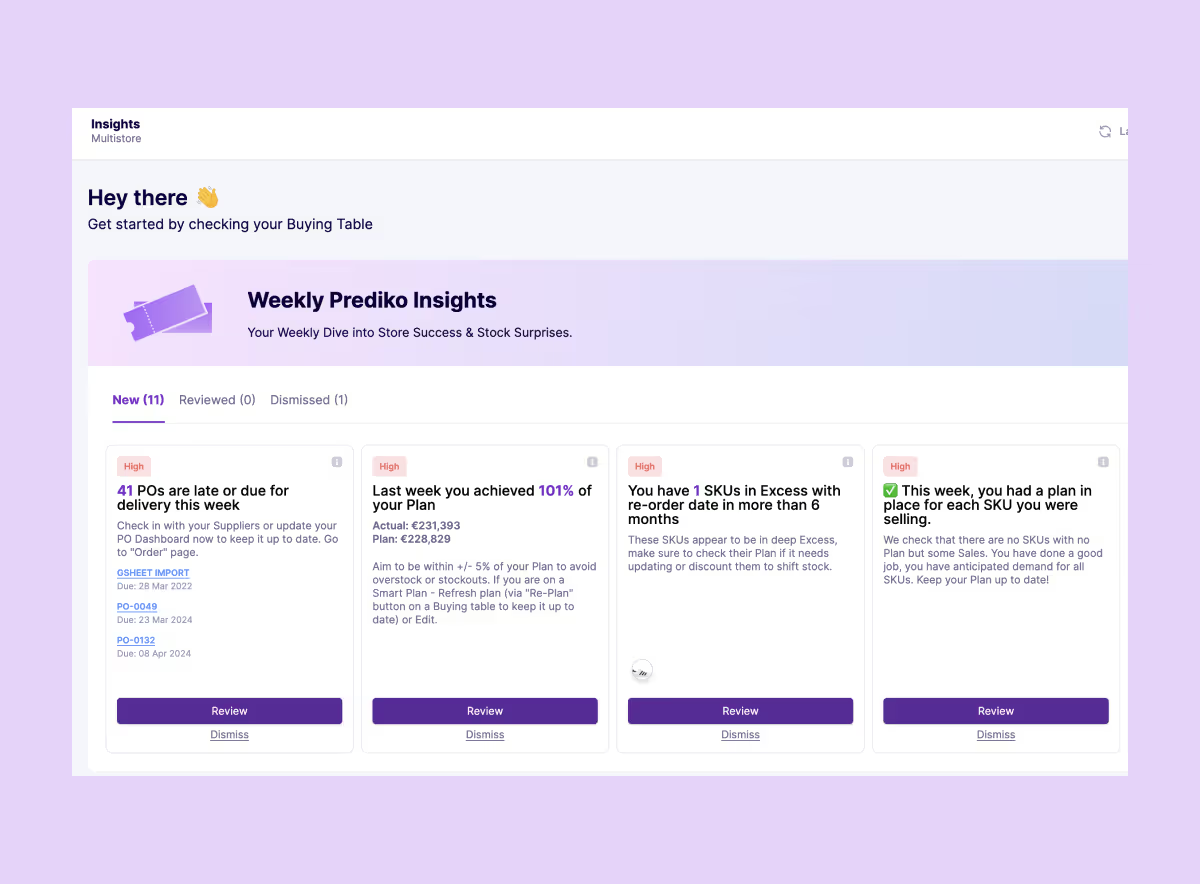
Pros
1. AI Sales Forecasting: Easily plan demand for SKUs and products, ensuring you always have the right inventory levels.
2. Proactive Inventory Planning: Stay ahead of stock issues with out-of-stock alerts and a smart buying planner that helps you make informed purchasing decisions.
3. Efficient PO Management: Simplify your purchasing process by creating, tracking, and bulk-editing purchase orders with ease.
4. Detailed Inventory Reports: Generate accurate, customizable inventory reports in CSV or PDF format, with over 100 filters for precise data insights.
5. Bill of Materials Management: Streamline production by creating BOMs and ordering components directly for your finished goods.
6. Starts at just $49/month — budget-friendly for small and growing Shopify brands.
Pricing
Our pricing scales with revenue of our customers. Our plans start from $49/month.
Magestore offers inventory management app tailored for the apparel sector. It provides features such as multi-warehouse management, stock transfer, and demand forecasting. Magestore's user-friendly UI and robust reporting capabilities makes it a popular choice among apparel retailers.
Pros
- Wide range of extensions: Offers collection of magento extensions tailored for various eCommerce needs, including inventory management, SEO, and customer engagement.
- Customization: Customization for Magento stores, allowing businesses to enhance their online store's functionality.
- Integration: Integrates with Magento, making it a natural choice for Magento-based stores looking to extend their functionality
Cons
- Magento Dependency: Mage Store extensions are specifically designed for Magento, so they are not useful for businesses using other e-commerce platforms.
- Complex Setup: Some extensions may require technical expertise to install and configure, which could be challenging for users without a development background.
- Cost Accumulation: While individual extensions might seem affordable, the cost can add up quickly if you need multiple extensions or ongoing updates
Pricing
Magestore has flexibile POS pricing and it depends upon the number of stores.
Lightspeed retail is cloud-based inventory management tool that offers range of features including stock ordering, inventory tracking, and sales reporting. Particularly beneficial for apparel retailers due to its size matrix feature, that simplify management of apparel items of different sizes and colors.
Furthermore, Lightspeed Retail's integration capabilities with eCommerce platforms make it a versatile tool for omnichannel retailers.
Pros
- Cloud-based: Accessible from anywhere with internet connection, allowing for real-time updates & management
- Omnichannel capabilities: Integrates in-store and online sales channels, providing seamless experience across both.
- Integrations: Works well with various e-commerce platforms, accounting software, and other business tool
Cons
- Learning Curve: While user-friendly, the system has a learning curve, particularly for users who are not tech-savvy.
- Limited Customization: Some users find that the customization options for reports and workflows are limited compared to other POS systems.
Pricing
Basic plan starts at $69 per month for one register.
Fishbowl is inventory management app that integrates with QuickBooks, making it ideal choice for retailers seeking to streamline their inventory and accounting processes. It offers features such as barcode scanning, order management, and advanced reporting.
Pros
- QuickBooks Integration: Integrates with QuickBooks, making it a powerful choice for businesses already using QuickBooks for accounting.
- Advanced Inventory Management: Handles complex inventory needs, including multi-location management, barcode scanning, and order management.
- Manufacturing Capabilities: Offers robust features for manufacturing businesses, including work orders, bill of materials, and inventory tracking through the production process.
Cons
- High upfront cost: The initial cost of purchasing Fishbowl can be prohibitive for small businesses, especially when considering the need for multiple user licenses.
- User Interface Some users find the interface outdated and not as intuitive compared to more modern software solutions.
- QuickBooks dependence: While integration with QuickBooks is strength, it also means that businesses not using QuickBooks may not get as much value out of Fishbowl.
Pricing
Available on their website.
Zoho Inventory is cloud-based inventory management tool that offers features such as multi-channel selling, order fulfilment, and inventory control. It's cloud-based nature facilitates remote access, making it a flexible solution for businesses with multiple locations.
Zoho Inventory's robust integration capabilities with various eCommerce platforms and shipping carriers make it a comprehensive solution for managing inventory in the apparel retail sector.
Pros
- User-friendly interface: Easy to navigate, making it accessible even for users with little technical knowledge.
- Multi-channel sales management: Manages inventory and sales across multiple platforms like Amazon, eBay, Shopify, and Etsy.
- Automation: Automates many routine tasks, such as order fulfilment and stock updates, saving time and reducing error.
Cons
- Limited advanced features: While Zoho Inventory is robust for small to medium businesses, it lacks some advanced features needed by larger enterprises or businesses with very complex inventory needs.
- User limitations: The number of users and orders in the lower-tier plans might be restrictive for growing businesses, forcing them to upgrade to more expensive plans.
- Integration issues: While it integrates well with other Zoho products, integrating Zoho Inventory with non-Zoho third-party apps is sometimes be challenging or limited.
Pricing
$79 per organization per month, which includes 1,500 orders per month and two users.
Also learn about the best 10 themes on Shopify for fashion clothing stores in 2025.
Common problems fixed by the right apparel inventory management tool
Two immediate issues that are fixed by having the right apparel inventory management tool:
1. Preventing excess inventory and reducing carrying costs.
2. Reducing stockouts and overstocks.


.png)






